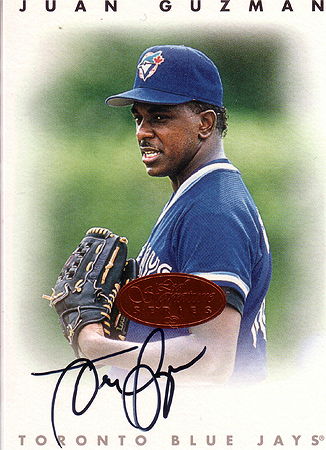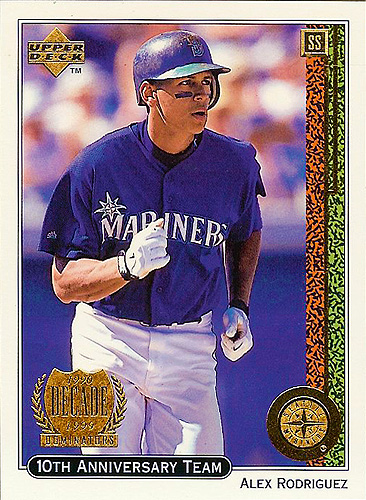
1989 Donruss Baseball's Best
In 1989, I was beginning my love affair with the Toronto Blue Jays. To be honest, rather than being drawn to any one player, as John Olerud was not yet with the team, I was most drawn to the team’s uniforms and logo. Now come on, you have to admit that’s one badass logo, and it would be great if they’d go back to it. Anyway, I was excited to find out the Blue Jays had a cool new rookie that seemed to have five-tool stuff; that guy was Junior Felix.

1989 Donruss The Rookies
Side note: I immediately noticed that this photo and the previous photo are obviously from the same at-bat, same photographer and everything. I mean, not only same at-bat, but seconds apart. I did a double-take when I saw it, but noticed that the flex of the arms is slightly different, and the guy in the background has moved a bit. Still, wow. 1989 Baseball’s Best was a tremendous improvement over the 88 series when it came to photography, but this was one of those choices that showed that the series was still a “B” product at best.

1989 Fleer Update
Junior rose through the Blue Jays system pretty quickly, becoming known for his quick wrists, which produced a lot of power despite his scrawny size, and his speed on the basepaths. I get the impression he wasn’t expected to make the team in 1989, but had a scorching Spring Training, wrapping up with a .314 batting average. The team was forced to send him down at the end of Spring Training, but recalled him at the beginning of May when Manny Lee went on the DL. He debuted on May 5th and became the 53rd player to hit a home run in his major league at-bat, a solo homer off of Kirk McCaskill.

1989 Score Rookie and Traded
And hey, he did have a lot of speed…but unfortunately no clue on how to harness it. While he stole 18 bases in his rookie year, a rather good total, he was also caught an atrocious 12 times. At that point, his stolen bases are a net loss, and after that rookie year and his second year, his SB totals dropped like a rock. I’m guessing that once the Angels acquired him and saw what a lousy base stealer he was, they stopped running him.

1989 Topps Traded
Overall, though, he didn’t have a terrible rookie campaign, especially for a 21-year-old at the major league level. He hit .258/.315/.395 (the OBP was particularly worrying), with 9 homers, 14 doubles, and a great 8 triples. That right there is where his speed really should have shone. And hey, a 105 OPS+ for a rookie outfielder isn’t bad. His defense wasn’t very great, though, which would be another problem. Oh, and he got to the postseason for the first and only time that year, as the Blue Jays played the A’s in the ALCS. He went 3-for-11 in the series, with a double, nary a walk, and two strikeouts. In retrospect, it’s clear that he had glaring flaws in his game, and they would become more and more exploitable as time went on.

1989 Upper Deck High Numbers
I didn’t care about all of that stuff at the time, though. Felix was another player revealed to me via the Upper Deck High Numbers, and I was excited the more I read about him. I had learned about why it was important to buy in on players who make the majors at a young age, as they have more of a chance of making the Hall of Fame, so I thought he had a shot for sure, and when he hit even better in 1990, I was ecstatic. Then came the trade to the Angels in the 1990 offseason, and I was confused. Were Devon White and Willie Fraser really worth a budding superstar in the making?
Whoops. Yeah, they were. Or at least Devon White was. He would help the team win back-to-back championships, while Felix fell off significantly in California between 1991 and 92 (to be fair, he was stricken with a calf injury for most of 91), then landed with the Marlins in their inaugural season. I’ll let this stuff go for a bit, though, because I’m sure we’ll see more of Junior in future iterations of these projects. Suffice it to say, his career would not live up to the expectations.







































